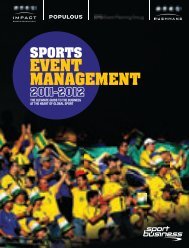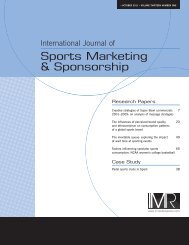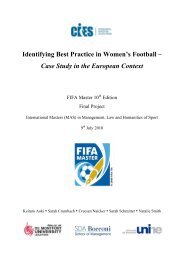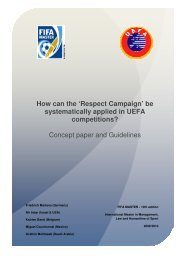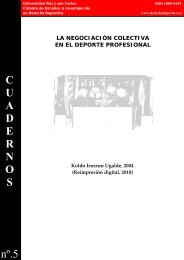Sports Marketing & Sponsorship - FIFA/CIES International University ...
Sports Marketing & Sponsorship - FIFA/CIES International University ...
Sports Marketing & Sponsorship - FIFA/CIES International University ...
- No tags were found...
You also want an ePaper? Increase the reach of your titles
YUMPU automatically turns print PDFs into web optimized ePapers that Google loves.
Stade Français Paris rugby clubdisplay and the feat of the athletes in relation to thedramatic and theatrical intensity of the spectacle. The‘interactive’ profile is essentially reactive and refers tothe emotional dimensions of the games in relation towhat happens both on and off the field. The‘supporter’ profile describes active and engagedsupporting behaviour towards a team. Theseconsumers consider themselves as actors in thespectacle. Last, the ‘opportunist’ profile corresponds toindividuals who use the spectacle for utilitarian valuessuch as economic or political interests withoutinvolving themselves in the event. Even if theseprofiles are not mutually exclusive they identifyrelevant behaviours and attitudes that allow marketersto create segments.Furthermore, Bourgeon and Bouchet (2001) definedthe relationships and the compatibility between thedifferent profiles which are particularly important froma marketing perspective. Indeed, they considered thatthe aesthete and interactive profiles arecomplementary, as are the opportunist and supporterprofiles. There is a discord between the opportunistand aesthete profile and between the supporter andthe interactive profile. Finally, there is a contradictionbetween the opportunist and the interactive profilesand between the supporter and the aesthete ones.The authors not only segment the population, theyevaluate the degree of compatibility between thedifferent segments with the aim of producing amultiple strategy. However, they failed to providecrossing characteristics such as socio-demographics inorder to determine who presents such profiles.Of a similar theme, but less theoreticallygrounded, Hunt et al (1999) proposed a classificationof sports fans according to theirlevel of attachment to the team, from the ‘temporary’,‘local’, ‘devoted’ and ‘fanatical’ to the ‘dysfunctional’fans. This framework suffers from the sameshortcomings as Bourgeon and Bouchet (2001),because it cannot put a face to these people. Anexception to this is probably dysfunctional fans whoseactions, as highlighted in the media, are easilyrecognised.In a more pragmatic way, Tapp & Clowes (2002)segmented football fans according to their level ofloyalty measured by attendance frequency and bywhat they termed ‘the product need’, measured byconsumption behaviour on the day of the match.We think that consideration of these differentframeworks helps us to better understand the nextsteps of strategic marketing: targeting and positioning,which respectively rely on the choice of segments andthe methods used to compete with others within theselected segments.The basic segment for professional teams iscomposed of what Hunt et al (1999) identified as thedevoted and the fanatical fans. By definition they arestrongly attached to a specific club or sport. In thecase of SF Paris, this segment is relatively small.Indeed, we can estimate it to be no more than10,000 people in the Parisian region considering thatthe average attendance for SF Paris was 8,385 and1,141 for Racing-Metro for the 2006-07 season(LNR). Max Guazzini realised that SF Paris had totarget other, newer segments.The first segment, chosen mainly because of itssize, relies on what Bourgeon and Bouchet (2001)termed the interactive profile. The club targeted peoplewho want to share, to enjoy and to participate.Essentially they were identified as young, without agood knowledge of the rules or the world of rugby, andas local and temporary fans. This segment was alsoincreasingly made up of women and girls because, asGantz & Wenner (1991) stated, women are morelikely to watch televised sports for companionship andsharing with family and friends. In such cases, thetarget is represented by the whole family andparticularly by the parents, because they are thedecision-makers.Bourgeon and Bouchet’s (2001) work suggests thatSF Paris is also segmented on aesthetic lines. Indeed,people with an aesthete profile are attracted by thedramatic and theatrical dimension of the spectacle andpresent a complementary relationship with theinteractive profile. We can also predict that the sociodemographicprofile of the two groups is very similar.CASE STUDY● APRIL 2009 ● <strong>International</strong> Journal of <strong>Sports</strong> <strong>Marketing</strong> & <strong>Sponsorship</strong>255






